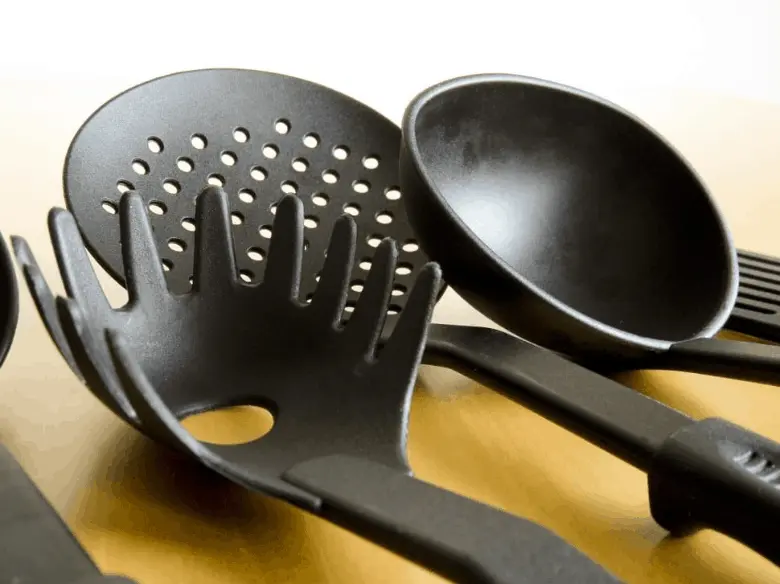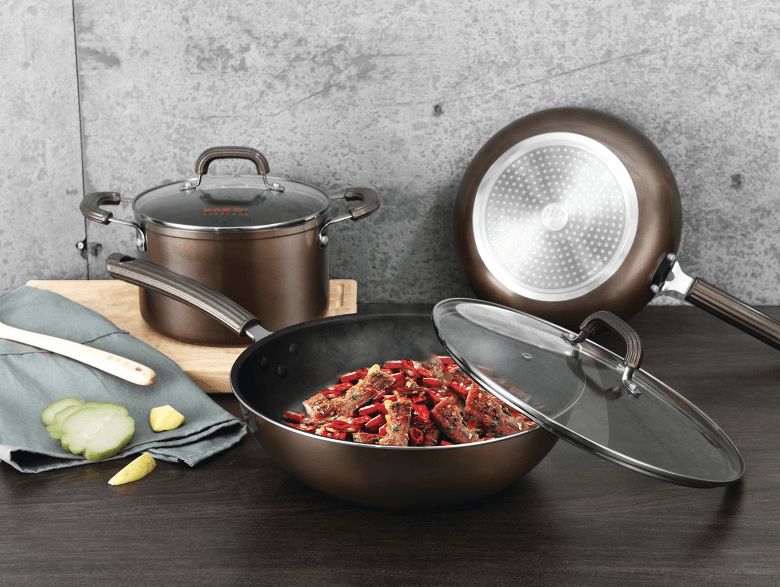If you don’t have time to read the article, my top pick is the Cuisinart Multiclad Pro Stainless Steel Cookware. Great quality and performance at a great price make this set a winner.
While you may already understand the importance of eating organic food to keep your family from consuming toxic chemicals, it’s equally important to prepare your meals in cookware that doesn’t leach toxins into your food while cooking it. So, let’s check out what’s the best non toxic cookware for health.
I’ve researched a ton of products and come up with a list of the best non-toxic cookware on the market right now.
Here are the cookware sets I’ll be reviewing:
- GreenPan Lima Ceramic Non-Stick Cookware
- Le Creuset Cookware
- Cuisinart MCP-12N Multiclad Pro Stainless Steel Cookware
- OXO Good Grips Non-Toxic Cookware
- Lodge Cast Iron Pre-Seasoned Cookware
What Kind of Cookware is Non-Toxic?
The best non-toxic cookware usually comes in one of five different types of materials. If you’re in the market for safe utensils, pots, pans, and other kitchen items you should look for products made from the following:
- Cast iron
- Stainless steel
- Ceramic/ceramic-coated
- Glass
- Silicone
Cast Iron
Cast Iron is one of the oldest materials used to make cookware. This material is durable, reliable, and has excellent heat retention. Cast Iron is also very attractive to the eye. With proper care, it lasts a long time. Cast iron needs to be seasoned. Seasoning is a process that allows cast iron to be nonstick and prevents rust. For everything you need to know about seasoning please read our guide on the subject.
Stainless Steel
Stainless steel also conducts heat very well, and it tends to distribute it more evenly than cast iron. Less experienced cooks find stainless steel more comfortable to work with since it heats more evenly and lessens the chance of accidentally burning your food.
Stainless steel is lower maintenance than cast iron and easier to maneuver as you cook because it weighs much less than cast iron.
Ceramic/Ceramic-Coated
Ceramic cookware is entirely metal-free and is considered the most environmentally friendly option. Ceramic is actually hardened clay. Its natural glaze is the only coating, so you don’t have to worry about any flaking or leaching of heavy metals. In other words, it’s 100% natural. If you’re particularly concerned with food safety, ceramic cookware is considered the safest option.
Ceramic-coated cookware is metal cookware coated in a layer of ceramic. Both ceramic and ceramic-coated cookware is considered nonstick. However, depending on the quality of the ceramic cookware, the nonstick properties don’t last.
Glass
Glass cookware is another safe non-metal alternative. Glass is best for cooking in the oven, but some glass cookware is stovetop safe. Unfortunately, glass isn’t the most efficient option for the stovetop because it doesn’t spread the heat evenly. However, if you have a glass-top stove, glass cookware won’t scratch it. Glass cookware is dishwasher safe, but it’s much more fragile than metal.
Silicone
Silicone is a newcomer in cookware, but it’s quickly gaining in popularity, particularly for bakeware. Food grade silicone (which must meet FDA standards) will not leach into food and will not support microbiological growth. Many people value silicone for being naturally nonstick, easy to clean, and safely used in the oven (up to 500° F) or placed in the freezer. It should not be used on the stovetop or broiler.

How to Choose the Best Type of Non-Toxic Cookware
While all the cookware types mentioned above are non-toxic, depending on your needs and cooking style, you may find one kind of cookware better for you than another. When deciding what type of cookware is your best option, consider the types of food you cook and how. Also, think about how long you’re willing to spend cleaning and maintaining your cookware and how durable it needs to be.
Consider Your Cooking Style
If you do a lot of searing, you will do well to invest in some cast iron or stainless steel cookware. Those who tend to do a lot of cooking in the oven will find glass and silicone are strong contenders. Silicone is also your best nonstick option. It could be advantageous to use silicone if you’re trying to keep your cooking low fat since no additional oil or grease is needed.
For cooking frequently using high heat, ceramic is best for taking the heat without the pan coating breaking down, or emanating toxic fumes. Cooks that tend to cook with a lot of acidic foods such as tomatoes, peppers, citrus, and vinegar would be better off steering clear of cast iron. The acid in these foods can deteriorate the nonstick surface properties of cast iron seasoning.
Cleaning and Maintenance
If you’re fine doing a little extra maintenance, then seasoning cast iron might not be a problem. Likewise, if you don’t mind taking the time to hand wash your cookware, you also have more options than if you need something that is dishwasher safe.
Durability and Life-expectancy
If you want something that will last you for a long time, then stainless steel or cast iron will be your best choice. If you’re okay with replacing your cookware every few years, ceramic and glass will suit you.
Glass is the least durable, non-toxic cookware. If you’ve ever had the experience of bumping a glass pot and having it shatter all over your kitchen counter as I have, you’ll probably think twice about getting another one.
Silicone is flexible and has excellent temperature stability; however, you need to make sure you keep it away from sharp objects and direct heat. A sharp knife can cut through silicone, and if you accidentally leave it on a stove or other direct heat source, it can melt.

Precautions to Take with Non-Toxic Cookware
Although well-maintained non-toxic cookware won’t leach toxic chemicals into your food, there are certain things you need to be aware of before purchasing these products.
Cast Iron
Stay away from cast iron if you have a problem with high blood iron levels. Even rust-free cast iron will absorb some iron traces into your food, so be careful if this is an issue for you. However, iron deficiency is a problem for many people, and adding a bit from your cast iron pans can be beneficial.
Cast Iron also retains heat for a long time so you can easily burn yourself if you’re not careful even if it’s been away from the heat source for a while. Always make sure you use potholders and never put cast iron on an unprotected surface.
Stainless Steel
Stainless steel is the master of messes. When misused, food tends to stick to them readily. When heating stainless steel, you need to be patient as it can take a while to heat up to the correct temperature before you can add oil to make the pan so that food won’t stick.
Ceramic Coated
If you choose to go for ceramic coated cookware, make sure it’s USA-made. The FDA has strict standards, but there have been some reports of ceramic-coated cookware imported from other countries that contain cadmium and/or lead, both of which are highly toxic.
Glass
Besides the obvious fragility of glass, heat is not always distributed evenly. This uneven distribution can cause the pot to form hotspots that could potentially cause the glass to crack. This tends to be more of a problem on the stovetop than the oven.
Silicone
Silicone isn’t the sturdiest material. You always need to make sure you have something more solid underneath it to keep it steady. I speak from experience; there’s nothing more depressing than baking chocolate chip cookies on a silicone baking sheet only to have the baking sheet flip over when you’re taking them out of the oven and cookies falling all over the kitchen floor.
Related: Our Cookware Buying Guide. How To Find Your Perfect Set.
Best Non-Toxic Cookware Product Reviews
GreenPan Lima Ceramic Non-Stick Cookware
GreenPan Lima Ceramic Non-Stick cookware is scratch-resistant and features stainless-steel easy to grip handles. GreenPans are ceramic-coated anodized aluminum and are guaranteed to be lead and cadmium-free. They’re nonstick and easy to clean, but be aware that they’re hand wash only. GreenPans all feature a glass top so you can easily observe how your food is cooking.
Pros
- The lightweight aluminum body makes for easy lifting.
- The nonstick surface is guaranteed to be lead, cadmium, PFAS, and PFOA free, so you can feel safe using them.
- Oven safe up to 600°F (lids up to 425°F)
- The pots and pans heat evenly.
- These pans are very easy to clean.
Cons
- They can only be hand-washed, or the nonstick coating will start coming off.
- Not suitable for induction stovetops.
- The outside and bottom of pans will get black stains with continual use.
- A lengthy list of care requirements.
Le Creuset Cookware
Le Creuset combines cast iron, enameled steel, and stoneware for their cookware, and uses silicone and wood for their cooking utensils. Although it’s definitely on the pricey side, the products are well worth it for their high quality and durability.
Pros
- Le Creuset cookware distributes heat evenly and retains it well.
- The brightly colored enamel is attractive, along with being chip and crack resistant.
- This cookware is very easy to clean.
- Can be used on all types of stovetops, including induction.
- Le Creuset generally requires no special care.
Cons
- The cookware is very expensive.
- Although most pieces are made in France, some such as some stoneware and enameled steel pieces are made in China and may be of lower quality.
- Although it claims to be nonstick, you have to keep stirring the food so it won’t stick.
- The handles can get very hot, so always use a potholder.
- Le Creuset is heavy and some of the larger pieces may require two hands to lift.
Cuisinart MCP-12N Multiclad Pro Stainless Steel Cookware
Cuisinart Multiclad Pro Stainless Steel Cookware has an aluminum core with a stainless steel exterior. The cookware doesn’t stain easily, and if staining does occur, it’s easy to clean up. This cookware works with both regular and induction-style stovetops. The design assists in easy pouring, which means less wasted food and less time cleaning up spills.
Pros
- The aluminum core allows it to heat quickly while the stainless steel exterior makes it very durable.
- The cooking surface does not react with food or alter favor.
- This cookware is less expensive than other cookware sets.
- The pots can be shined to look like new with ease.
Cons
- Sometimes the pots and pans can heat up too quickly and burn your food if they are too hot.
- They are not nonstick.
- They claim to be dishwasher safe, but hand washing is best.
- Some warping might occur if you use an electric stove.
OXO Good Grips Non-Toxic Cookware
Oxo Good Grips are both stovetop and oven safe up to 390°F. They are aluminum and feature a nonstick non-toxic coating. The handles are stainless steel and covered with silicone, so you don’t have to worry about burning your hands on the handle. However, all nonstick coatings wear out over time. The Oxo Good Grips last longer than most nonstick cookware with proper care.
Pros
- These pans wipe clean without having to scrub them.
- The silicone and stainless steel handles are easy to grip and don’t get hot.
- The nonstick coating lasts longer than many other nonstick pans.
- These pans won’t warp or bulge at the bottom when heated.
- The pans are lightweight, without sacrificing sturdiness.
Cons
- The nonstick coating will begin to peel off with heavy use.
- These pots and pans tend to scratch easily, even with silicone or wood cooking utensils.
- The frying pans are shallow, and so they have limited capacity.
- Many of the pots and pans tend to get dented along the rim.
Lodge Cast Iron Pre-Seasoned Cookware
Lodge has long been the name in cast-iron cookware. It’s one of the oldest cookware companies in existence with a history going back as far as the 19th Century. Most of its products are still made in the USA. Lodge cookware comes pre-seasoned, and all pieces come with a one-year money-back guarantee.
Pros
- Comes pre-seasoned to save you some labor.
- All Lodge products come with a one-year money-back guarantee.
- Cookware will not chip.
- Made in the USA.
- The set should last a lifetime with proper care.
Cons
- These pans will have to be seasoned regularly.
- Cookware is extremely heavy, so it is hard to lift and maneuver.
- Must be hand washed to preserve the nonstick surface.
Conclusion and All-Around Winner
While not all non-toxic cookware is created equal, I’m sure one of the products suggested in this round-up will suit your personal needs. If I were going to declare an all-around winner, the Cuisinart Multiclad Pro Stainless Steel Cookware would make the top of the list.
It’s much more economical than Le Creuset, and you don’t have to worry about any nonstick coating that could peel off into your food. It also requires much less maintenance than Lodge cast-iron, but it’s still pretty durable.
As with any stainless steel cookware Cuisinart Multiclad will take a little experimentation before you figure out how much to heat it before adding oil so food doesn’t stick, but it’s generally more forgiving than cast-iron and easier to control the temperature. Plus, even if you do screw up and burn something, it will be less of a hassle to clean up the mess. A great cookware set at a great price.





